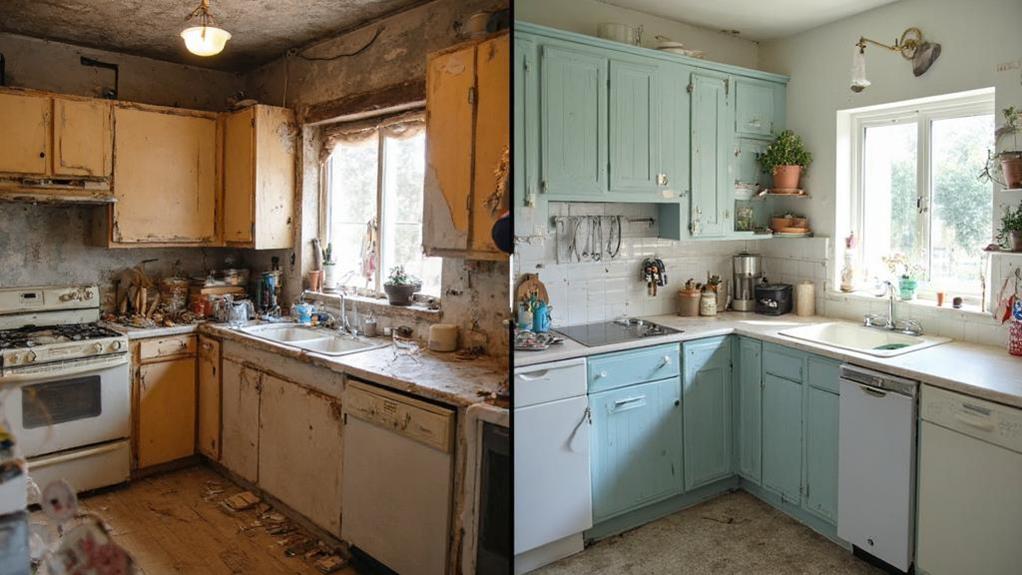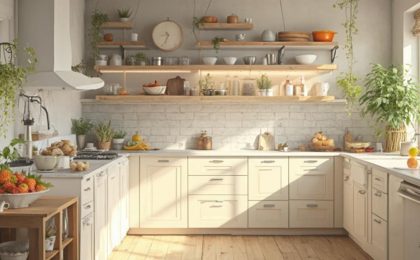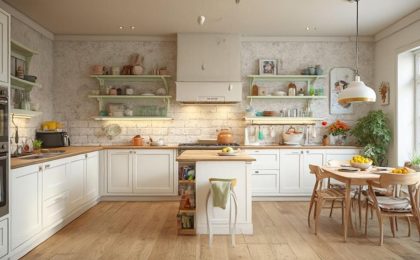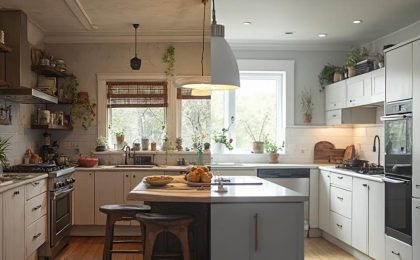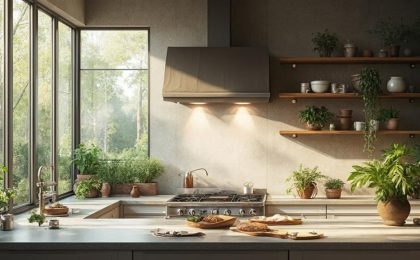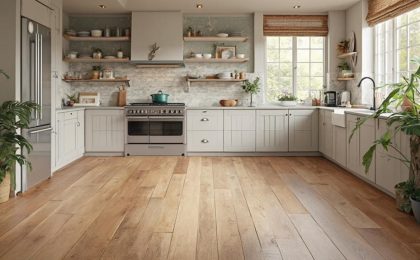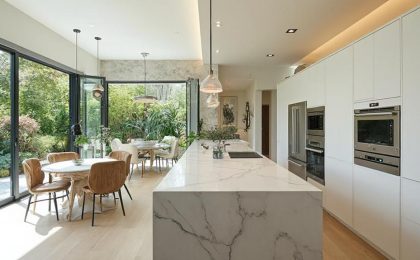When you're planning a kitchen renovation, it's easy to underestimate the complexities involved. You might think a quick makeover will suffice, but common mistakes like inadequate budgeting or choosing the wrong contractors can lead to headaches down the line. It's essential to prioritize a solid design plan and consider every detail, from storage solutions to lighting needs. As you navigate this process, keep in mind that overlooking these aspects can derail your project entirely. So, what are the key steps you should take to guarantee a smooth renovation?
Key insights
- Failing to create a comprehensive budget can lead to financial strain; include unexpected expenses and build a contingency fund of 10-15%.
- Skipping detailed design planning can result in costly mistakes; utilize design tools and consult local professionals for tailored insights.
- Not verifying contractor credentials can lead to unreliable work; ensure licenses, insurance, and positive references before hiring.
- Neglecting proper lighting considerations can affect functionality; assess ambient, task, and accent lighting for a well-lit workspace.
- Overlooking permit requirements can cause project delays; research local regulations to ensure compliance and avoid legal issues.
Underestimating the Budget
Underestimating the budget can derail even the most well-planned kitchen renovation. You might think you've got it all figured out, but a thorough budget breakdown is vital to avoid costly surprises.
When you set your initial budget, include every aspect of the renovation, from cabinets and countertops to appliances and labor. It's important to account for unexpected expenses that can arise, like plumbing issues or the need for additional electrical work. Local experts, like Kitchen Fitters Bradford, can provide valuable insights on costs specific to your area and help you avoid common pitfalls.
As you progress, those seemingly minor costs can add up quickly, stretching your finances thin. It's not uncommon for homeowners to overlook certain details, such as permits or design fees, which can lead to major headaches down the line.
To safeguard against these pitfalls, build a contingency fund—about 10-15% of your overall budget—specifically for those unexpected expenses.
This proactive approach not only eases financial strain but also allows you to focus on creating your dream kitchen without the constant worry of overspending.
Ignoring the Importance of Planning
A well-thought-out plan is the backbone of any successful kitchen renovation. You might think diving into a renovation without a detailed strategy is tempting, but it can lead to chaos and oversights.
Start by carefully mapping out your kitchen layout. Consider how you use the space, the flow of movement, and the placement of appliances. This will help you create a functional design that meets your needs and fits your lifestyle. Additionally, consulting with local professionals can provide insights into custom kitchen design that aligns with your vision.
Next, establish a renovation timeline. Without a clear timeline, you could face delays that disrupt your daily life, not to mention added costs.
Break your project into phases, and allocate time for each stage, from demolition to final touches. Be realistic about how long each task will take, factoring in potential setbacks.
Choosing the Wrong Contractors
Choosing the right contractor can make or break your kitchen renovation. It's crucial to prioritize contractor qualifications, ensuring they've the necessary skills and experience for your specific project.
Begin by verifying their licenses, insurance, and references, as well as their expertise in local architectural styles and building regulations, which can greatly impact your renovation. A qualified contractor not only brings technical expertise but also a solid reputation in the community, often supported by positive customer testimonials.
Next, establish clear communication expectations from the outset. Discuss how often you'll check in, preferred methods of communication, and what updates you can expect throughout the renovation process.
A contractor who values transparency will keep you informed about timelines, budget changes, and any potential issues that arise.
Don't shy away from asking questions or voicing concerns; a good contractor will encourage this dialogue. Miscommunication can lead to costly mistakes, so be proactive in your interactions.
Overlooking Storage Solutions
When planning your kitchen renovation, it's easy to get caught up in aesthetics and overlook the importance of effective storage solutions. However, neglecting storage can lead to a cluttered and dysfunctional space.
To maximize your kitchen's potential, think about incorporating creative storage options that cater to your cooking habits and lifestyle.
Start by evaluating your needs. Do you require more pantry space, or do you need to store pots and pans more efficiently? Consider vertical storage, such as shelves that reach the ceiling or wall-mounted racks for frequently used items. Pull-out drawers and lazy Susans can make accessing ingredients a breeze.
Multifunctional furniture can also be a game-changer. A kitchen island that doubles as a prep station and dining area can save space while enhancing your kitchen's functionality.
Look for benches with hidden compartments or tables that expand when you have guests.
Skipping the Design Process
Skipping the design process can lead to costly mistakes and a kitchen that doesn't meet your needs. When you rush into renovations without a clear plan, you might overlook vital elements like functionality and flow.
Using design tools, such as 3D modeling software or sketching apps, can help you visualize your space and refine your ideas.
Exploring various layout options is essential; a poorly planned layout can make cooking and entertaining cumbersome. Are you considering an open concept? A traditional galley? Each has its pros and cons, and understanding them can guide your decisions.
Don't forget to involve key stakeholders in the design process. Talk to family members who use the kitchen regularly to gather their input. Their perspectives can uncover practical needs you might overlook.
Miscalculating Lighting Needs
Although the aesthetic appeal of your kitchen can be enhanced by beautiful fixtures, miscalculating lighting needs can greatly diminish functionality. To create a well-lit space, you must consider various lighting types, including ambient, task, and accent lighting. Each serves a purpose, and neglecting any can lead to a less efficient workspace.
Here's a quick overview of common lighting types and their roles:
| Lighting Type | Purpose |
|---|---|
| Ambient | Provides overall illumination |
| Task | Focuses on specific work areas |
| Accent | Highlights design features |
| Natural | Utilizes daylight for warmth |
| Decorative | Adds style and personality |
Additionally, you should factor in energy efficiency. Opting for LED lights can reduce your energy consumption while maintaining brightness. When planning, remember that the right combination of lighting types not only enhances aesthetics but also guarantees you can navigate your kitchen safely and efficiently. So, take the time to evaluate your lighting needs carefully, and your kitchen will shine in both style and function.
Failing to Consider Workflow
A well-designed kitchen isn't just about aesthetics; it's also about creating a seamless workflow that enhances your cooking experience.
When you're planning your renovation, don't overlook how your kitchen layout affects workflow efficiency. Poor design can lead to frustration and inefficiency, making cooking feel like a chore instead of an enjoyable activity.
To avoid this mistake, consider these three key elements:
- The Work Triangle: Position your sink, stove, and refrigerator in a triangular layout. This minimizes movement and maximizes efficiency, allowing you to move effortlessly between tasks.
- Zoning: Create specific areas for food prep, cooking, and cleaning. This organization helps you maintain focus and reduces clutter, making your kitchen more functional.
- Workflow Paths: Guarantee clear pathways between different zones. Avoid placing obstacles in high-traffic areas to prevent accidents and make it easier for multiple cooks to work simultaneously.
Neglecting Permits and Regulations
When planning a kitchen renovation, many homeowners focus on design and layout but often overlook the importance of permits and regulations. Neglecting these can lead to significant setbacks, including fines or even having to redo your work. Understanding permit requirements guarantees your project aligns with local building codes and safety standards, which is essential for successful regulation compliance.
| Permit Type | Description |
|---|---|
| Building Permit | Required for structural changes |
| Electrical Permit | Necessary for electrical system work |
| Plumbing Permit | Needed for plumbing alterations |
Before you start your renovation, check with your local authority to understand which permits are necessary for your project. Failing to secure these can halt your progress and create costly delays. By prioritizing permits and regulations, you'll not only avoid potential legal issues but also enhance the overall safety and quality of your new kitchen. Don't let oversight lead to regret—plan wisely, and make sure all your bases are covered from the start.
Disregarding Future Needs
When planning your kitchen renovation, it's essential to think ahead about your family's evolving needs.
Anticipating growth, considering aging in place, and allowing for lifestyle changes can prevent costly adjustments down the line.
Anticipate Family Growth
Ignoring the potential for family growth during a kitchen renovation can lead to significant regrets down the line.
Your kitchen layout should adapt to evolving family dynamics, ensuring it remains functional as your household changes. Whether you're planning for future children, hosting more gatherings, or welcoming extended family, considering these factors is essential.
Here are three key areas to focus on:
- Space for Expansion: Design your kitchen with enough room for additional appliances or seating. Open layouts can make it easier to incorporate new features later on.
- Flexible Storage Solutions: Invest in modular storage options that can be adjusted as your needs change. This versatility will help keep your kitchen organized, regardless of family size.
- Multi-Functional Areas: Create spaces that serve multiple purposes, like a kitchen island that can function as a dining area or a homework station. This adaptability will enhance your kitchen's usability over the years.
Consider Aging in Place
As you plan your kitchen renovation, it's crucial to think about how your needs might change as you age. Incorporating universal design principles can drastically enhance your kitchen's functionality and comfort over time.
Start by considering accessibility features that accommodate various mobility levels. For instance, opt for pull-out drawers instead of deep cabinets, making it easier to reach items without straining.
Install lever-style faucets and consider a touchless model to simplify tasks, especially when your hands are full or if arthritis becomes a concern.
Additionally, verify that your kitchen layout allows for wide pathways, facilitating easy movement with a walker or wheelchair if necessary.
Countertops at varying heights can also provide flexibility for different tasks, whether you're cooking or hosting.
Choose slip-resistant flooring to prevent accidents, and ample task lighting to improve visibility as eyesight changes.
Flexibility for Lifestyle Changes
Your kitchen is the heart of your home, and it should be designed to adapt to your evolving lifestyle. When planning your renovation, it's essential to reflect on how your needs may change over time. Ignoring this flexibility can lead to costly adjustments down the road.
Here are three key aspects to keep in mind:
- Open Floor Plans: Opt for an open floor plan that allows for easy flow between spaces. This can accommodate family gatherings, create a welcoming atmosphere, and provide versatility as your lifestyle shifts.
- Multi-Functional Spaces: Design your kitchen with multi-functional spaces in mind. Incorporate an island that serves as both a cooking area and a dining space, ensuring it meets various needs as they arise.
- Future-Proofing: Reflect on future needs like growing families or changing work-from-home situations. Flexible layouts and adaptable furniture can help your kitchen remain functional and stylish no matter how your lifestyle evolves.
Frequently Asked Questions
How Can I Find Reliable Kitchen Renovation Contractors?
To find reliable kitchen renovation contractors, start by researching contractor reviews online.
Look for detailed feedback from previous clients to gauge their reliability and quality of work.
Reach out to multiple contractors for budget estimates, comparing them to ascertain you're getting a fair deal.
Don't hesitate to ask for references or examples of past projects; this will give you confidence in your choice.
Trust your instincts, and choose someone who communicates well.
What Are the Best Materials for Kitchen Countertops?
When choosing materials for your kitchen countertops, consider durability and maintenance.
Granite, quartz, and solid surface materials are popular due to their resilience and ease of care. Granite offers a unique look but needs periodic sealing, while quartz is non-porous and requires minimal upkeep.
For a more budget-friendly option, laminate provides a wide range of styles, though it may not be as durable.
Always weigh your lifestyle and maintenance preferences before deciding.
How Long Does a Typical Kitchen Renovation Take?
A typical kitchen renovation takes anywhere from a few weeks to several months, depending on various timeline factors.
You'll go through multiple renovation phases, including design, demolition, and installation.
If you're making structural changes or waiting for custom materials, it might extend the timeline.
It's crucial to plan carefully and stay organized to keep things on track.
With proper management, you can enjoy your newly renovated kitchen sooner than you think!
Should I DIY or Hire a Professional for My Kitchen Renovation?
Deciding whether to DIY or hire a professional for your kitchen renovation hinges on budget considerations and design preferences.
If you've got the skills and a tight budget, tackling it yourself can save cash.
However, if your vision demands specific expertise or you want a seamless finish, hiring a pro might be the better choice.
Evaluate your comfort level with tools and techniques, and choose the path that aligns with your goals.
What Style Trends Are Popular for Kitchen Renovations Right Now?
Right now, modern designs are taking center stage in kitchen renovations.
You'll find sleek lines, open spaces, and minimalist aesthetics dominating the scene. Incorporating sustainable materials, like reclaimed wood and recycled countertops, not only enhances your kitchen's look but also promotes eco-friendliness.
Consider adding smart technology for added convenience and functionality. Embracing these trends will create a stylish, efficient space that reflects both contemporary tastes and environmental awareness.
Summary
By avoiding these common kitchen renovation mistakes, you can guarantee your project runs smoothly and meets your needs. Always plan meticulously, budget wisely, and choose the right professionals. Don't forget to take into account storage, lighting, and workflow, and keep future needs in mind. With clear communication and thorough preparation, you'll create a functional and stylish kitchen that you and your family will enjoy for years to come. Happy renovating!
